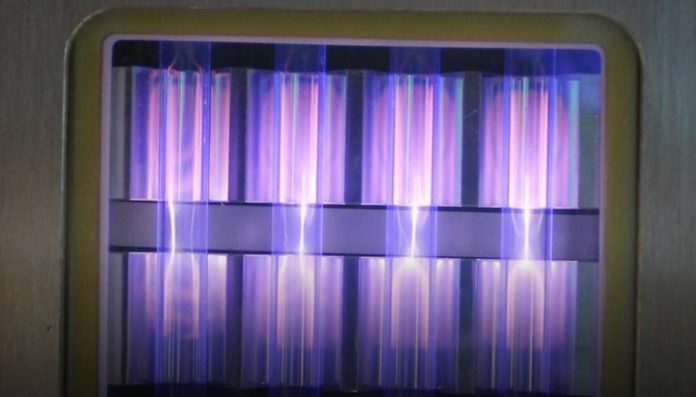The findings, published in the journal Applied and Environmental Microbiology, are the first to thoroughly examine the effects of several wavelengths of UV radiation on SARS-CoV-2 and other respiratory viruses, including the sole wavelength that is safe for living beings to be exposed to without protection.
The findings, which the authors describe as a “game changer” for UV light use, could lead to new affordable, safe, and highly effective technologies for reducing virus spread in crowded public settings such as airports and concert venues.
UV light is emitted by the sun naturally, and most wavelengths are damaging to humans and microbes like viruses. This light can be absorbed by an organism’s genome, tying it up and preventing it from replicating. The ozone layer, on the other hand, filters away these dangerous wavelengths from the sun before they reach the Earth’s surface.
Human-engineered UV light is used in certain common items, such as fluorescent tube lamps, but a white phosphorous coating on the inside protects people from the UV rays.
Hospitals currently employ UV light technology to disinfect surfaces while no one is present, utilizing robots that can shine UV light in operating and patient rooms when they are not in use.
Many products on the market now use UV light to clean everything from cell phones to water bottles. The FDA and EPA, on the other hand, are still working on safety measures. Authors warn against exposing a person to UV radiation using personal or “germicidal” devices.
According to the study author, the new findings are unusual because they touch the sweet spot between UV light that is reasonably safe for humans and UV light that is detrimental to viruses, particularly the one that causes COVID-19.
“This can be a game changer for the public use of UV light in indoor spaces,” said senior author Karl Linden, professor of environmental engineering.
Linden and his team used standardized procedures developed across the UV light industry to compare different UV wavelengths side by side for the study.
“We wanted to make sure that if UV light is being used to control disease, you’re delivering the right dose that’s protective of human health and human skin, but also going to be killing off these pathogens,” said the study author.
Working with SARS-CoV-2 requires highly stringent safety requirements, thus the opportunity to perform this type of work is rare. As a result, Linden and Ben Ma, a postdoctoral researcher in Linden’s lab, worked with virologist Charles Gerba at the University of Arizona, in a lab that had been cleared to work with the virus and its mutations.
While the virus was vulnerable to UV light in general, the researchers discovered that a specific wavelength of Far ultraviolet-C, at 222 nanometers, was particularly potent. This wavelength is very high energy, created by a krypton chloride excimer lamp, which is fueled by molecules travelling between different levels of energy. As a result, it’s able to cause more viral protein and nucleic acid damage than other UV-C devices while still being protected by the top layers of human skin and eyes, implying that it has minimal to no negative health impacts at dosages capable of killing viruses.
“Not only is it safe, it’s also the most effective,” said Linden.
The role of UV disinfection today
UV radiation has been used to disinfect water, air, and surfaces in various ways since the early twentieth century. It was used to prevent tuberculosis transmission in hospitals and classrooms as early as the 1940s by directing light at the ceiling to cleanse the air as it cycled throughout the room. It’s now used not only in hospitals but also in some public restrooms and planes when no one is there.
Linden and co-authors argue in a recent White Paper published by the International UV Association, “Far UV-C Radiation: Current State-of-Know,” that this safer wavelength of Far UV-C light, in addition to improved ventilation, mask-wearing, and vaccination could serve as a key mitigation measure against current and future pandemics.
Linden envisions devices that cycle on and off in indoor places to clean the air and surfaces on a regular basis, or that create a continuous, invisible barrier between teachers and students, consumers and service employees, and people in spaces where social distance is impossible, to disinfect the air.
By delivering the comparable protection of more air changes per hour within a room, UV light disinfection can even equal the positive effects of better indoor ventilation. Installing UV lights is also less expensive than replacing a whole HVAC system.
“There is an opportunity here to save money and energy while protecting public health in the same way. It’s really exciting,” said Linden.
You were reading: A low-cost, safe technique to stop COVID-19 spread – new study
